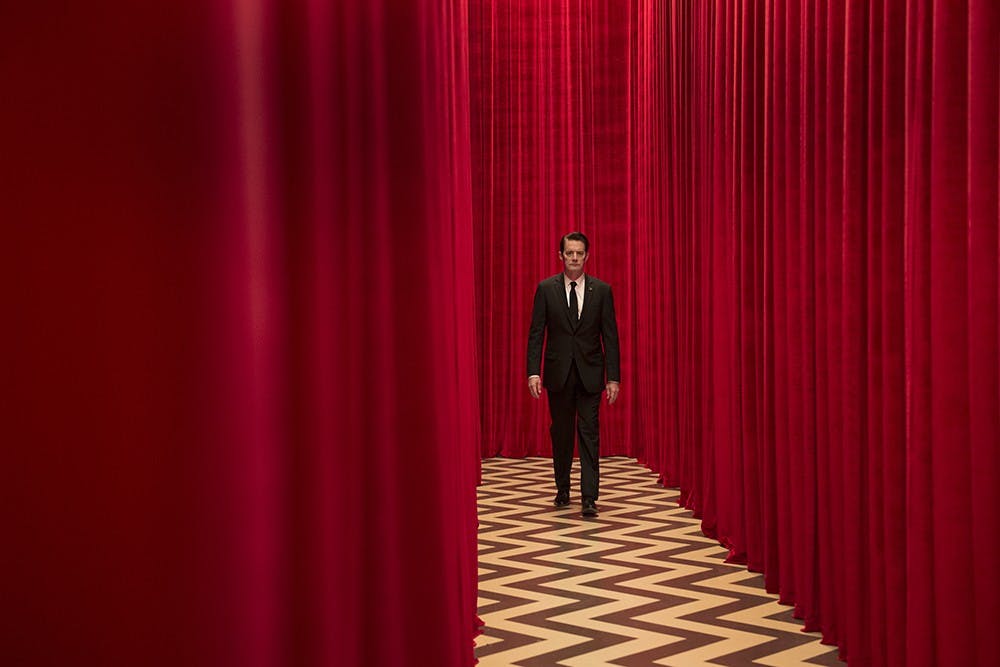Catch up on all things "Twin Peaks" ahead of its third season with Weekend's damn fine guide.
What is “Twin Peaks?”
Before the GIFs, Etsy crafts and Log Lady cosplay, there was a cheerleader. Dead. Wrapped in plastic. Her name was Laura Palmer, and her death shakes the Pacific Northwest logging town of Twin Peaks to its very core. When the FBI Special Agent with the heart of a Boy Scout Dale Cooper arrives in town to investigate, things take a turn for the Lynchian. Demons, alternate dimensions, aliens and extravagant quantities of cherry pie and black coffee recur across the show’s two seasons. After sinking ratings, "Twin Peaks" ended on a 26 year cliffhanger, and its new season debuted May 21 on Showtime. You can watch the first two seasons on Netflix.
Who is David Lynch?
As the sole director of "Twin Peaks's" third season, David Lynch is the creative force driving the series in 2017. He spent his early life as a painter before beginning his film career with a series of short surrealist horror films. After accepting a scholarship at the American Film Institute in Lost Angeles, Lynch began work on “Eraserhead” (1977), the success of which paved the way for his commercial and critical breakthrough, “The Elephant Man” (1980). After a fraught brush with mainstream Hollywood directing an adaptation of Frank Herbert’s sci-fi opus “Dune,” Lynch retreated to stranger realms with the neo-noir mystery “Blue Velvet” (1986).
Lynch’s most-beloved work is often sad, strange and funny all at once. Films like “Blue Velvet” and shows like “Twin Peaks” craft worlds where even the most banal of small town occurrences can drop out without warning into unfathomable nightmare. Lynch is a master of the surreal, and one of the few artists whose last name has become shorthand for an entire style of cinema. Anybody can make a film that feels like a dream. Lynch can do that, and he can make you feel like you’re the dreamer, too.
Why watch "Twin Peaks?"
The simple answer: it’s the most fun – and by a larger margin, the most popular – of David Lynch’s works. It has the most palatable ratio of offbeat humor to melodrama and irony to scares. Everything from "The Simpsons" to "Psych" has spoofed it, and your cool friend’s tumblr has probably played host to a handful of not-so-subtle references to the show.
The more complex answer: “Twin Peaks” captures everything about Lynch’s idiosyncratic style. The show stands as the best representation of the director’s fascination with the seedy underbelly of small town America and features some of the most horrific scenes he's ever shot. "Twin Peaks" is a landmark not just in television, but within it's creators extraordinary oeuvre as well.
So how much should I watch?
When the “Twin Peaks” pilot aired Apr. 8, 1990 on ABC, it was viewed by more than 34 million people. Its popularity alone makes the show’s two-hour debut episode worth watching for anyone with a passing interest in "Important Television." Beyond that, the first season manages to keep the plot moving with its offbeat combination of irony, Tibetan religion and people who talk backwards. That's all worth viewing.
Season 2’s first half begins strong before losing its way when the arc tracing Laura Palmer’s death is abandoned for a cat-and-mouse game between Cooper and his insane ex-FBI partner. Season 2 isn’t without its charms, though; Shout out to David Duchovny for his second-best role of the '90s as DEA Special Agent Denise Bryson.
What’s the deal with the new season?
The first two episodes of season 3 aren't rehashes of the first two seasons. They are stranger, darker and slower than "Peaks" past, with the possible exception of 1992’s feature-length film “Twin Peaks: Fire Walk with Me.” Conceived as a single 18-hour work, the new “Twin Peaks” probably isn’t meant to be judged episodically or this early on. But with its massive, all-star cast, sweeping scope and already-lurking mysteries, it’s looking like the strangest show of the '90s is coming back in style.
Are the owls what they seem?
"Twin Peaks” is a show about many things: Confederate soldier amnesia, cheerleaders with super strength and a lodge between dimensions all play their part. But most of all it is a show about darkness. As such, its mysteries aren’t meant to be solved; they exist rather to reference and reinforce the show’s two greatest themes - love and fear - than to contribute to a concrete plot.
Don’t treat "Twin Peaks" like other pop culture forces like “Lost” or “Game of Thrones.” Internet forums might offer a few logical fan theories on certain otherwise-unexplained phenomena in the show, but they won’t actually provide answers. Those searching for clues would be wiser to search out each episode's Log Lady intro online or track down a copy of “The Secret History of Twin Peaks” tie-in book. They will lead you to a place both wonderful and strange.




